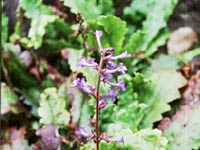 |
| The Healing Herb: Picrorhiza kurroa |
Picrorhiza kurroa (family Scrophulariaceae, common name Picrorhiza, Katuka, Kutka, kutki) is one of the
oldest medicinal plants found in the Himalayas. Since time immemorial, this
perennial herb has been used in Ayurveda for treating diseases caused by kapha and
pitta, and is valued for its hepatoprotective properties.
In small doses, it helps in curing loss of appetite, liver diseases, jaundice,
bronchial asthma, bile disorders and weakness. In larger doses, it is useful as
an antioxidant, antibacterial, anticholestatic,
antiallergic, antiperiodic, cathartic, laxative, and to treat abdominal diseases, adiposity
and related disorders.
The
leaf, bark and the underground parts of Picrorhiza,
mainly rhizomes are widely used in the treatment of the health ailments. The root of this plant is rich in glucosides including
kitkin and picrorhizin, cucurbitacin, D-mannitol, benetic acid, kutkisterol,
vanillic acid and some steroids. P.
kurroa also contains apocynin, a powerful anti-inflammatory agent, which helps
reduce platelet aggregation.
 |
| Picrorhiza kurroa |
Experimental studies have revealed the cytotoxic role of curcubitacins (found
in the plant) having antitumor activity. It is also said to reduce blood
cholesterol levels and the coagulation time. Furthermore studies of plant
rhizome, is shown to improve the immunity of the body, as well as known to have a specific action against the parasite Leishmania,
which causes the disease called leishmaniasis.
The plant is also used in treating abdominal
pain, stomach disorders, anemia, and for promoting bile secretion. It is
helpful in acute viral hepatitis, as immune-modulator, and in treating fever
and allergies. Other instances of use include vitiligo, skin disorders,
infections, scorpion stings, chronic diarrhea, epilepsy, malaria and rheumatoid
arthritis. The plant and its formulations are widely used in treating epidemic
jaundice.
No comments:
Post a Comment